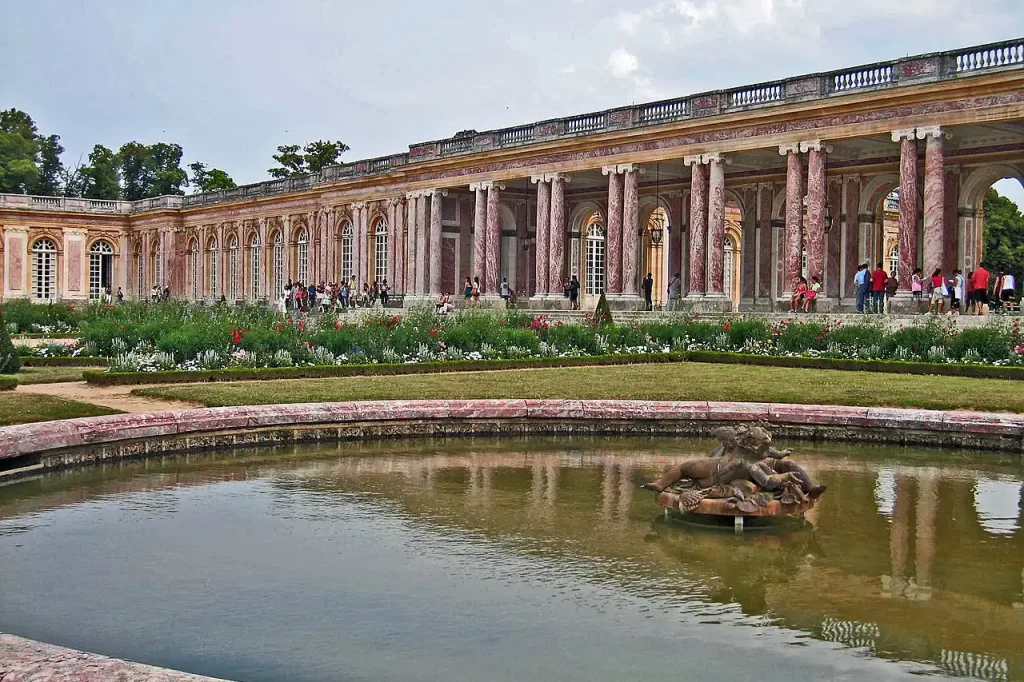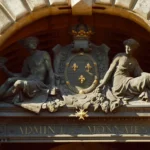The Palace of Versailles
Discover the splendor of the Palace of Versailles, a symbol of French royal grandeur. This historic monument, just outside Paris, is a stunning showcase of French art and architecture. The famous Hall of Mirrors, with its reflective grandeur, offers a glimpse into the opulence of the French monarchy. The vast Gardens of Versailles, a masterpiece of landscape design, feature meticulously crafted flower beds, statues, and impressive fountains, including the enchanting Musical Fountains Show.
The Grand Trianon and Petit Trianon, along with the rustic Queen’s Hamlet, provide a more intimate view of royal life, contrasting the main palace’s magnificence. The Royal Chapel and Opera exude architectural brilliance, while the King’s Grand Apartments display the lavish lifestyle of French kings. Versailles is also home to the Museum of the History of France, where art and artifacts narrate the nation’s story.
The Royal Stables, a testament to the equestrian culture of the court, add another layer to the Versailles experience. Seasonal exhibitions bring contemporary relevance to this historic site, making each visit unique. Versailles is not just a palace; it’s a journey through French history, art, and culture, leaving visitors awe-struck by its timeless beauty and historical significance.
The Hall of Mirrors

The Hall of Mirrors is a crowning jewel of Versailles, a testament to the grandeur and artistry of the French Baroque era. Walking through this magnificent hall, you are surrounded by 17 large mirrored arches, each reflecting the natural light and the beauty of the gardens visible through the 17 opposing windows. The effect is a stunning interplay of light and architecture, creating a sense of endless space and opulence.
This hall has witnessed significant historical events, including the signing of the Treaty of Versailles in 1919. Imagine strolling through the same space where kings, queens, and world leaders have walked, surrounded by elaborate frescoes and gilded statues. The ceiling, adorned with paintings depicting the achievements of Louis XIV, adds to the hall’s narrative, inviting you to gaze upwards and marvel at the artistic mastery.
As a traveler, taking a moment to stand in the center of the Hall of Mirrors is a must. It’s not just a walk through a grand hall; it’s an immersive experience into history and art. The mirrors reflect not just the physical beauty of the surroundings but also echo the rich history that has unfolded within these walls. It’s a perfect spot for photos, but also for a moment of reflection on the lavishness and the historical significance of Versailles.
The Gardens of Versailles

The Gardens of Versailles are a breathtaking display of symmetry, precision, and botanical beauty. Spanning over 800 hectares, these gardens are a masterful example of classic French garden design. With meticulously trimmed hedges, geometrically arranged flower beds, and a network of serene paths, the gardens invite you to wander and explore their beauty at your own pace.
Every corner of these gardens unveils a new surprise – from majestic fountains to quiet, secluded groves. The fountains, with their elaborate sculptures and periodic water shows, are particularly mesmerizing. The grandeur of the Fountain of Apollo or the playful charm of the Fountain of Neptune adds a magical touch to the garden experience. Seasonal floral arrangements ensure the gardens are a feast for the eyes throughout the year, showcasing the best of each season’s blooms.
For those who love leisurely strolls or picturesque picnics, the Gardens of Versailles offer the perfect setting. You can spend hours here, just soaking in the tranquility, admiring the artistry of the landscape, or even catching a musical fountain show that brings the gardens to life with synchronized water dances. It’s a place where nature and art intertwine, creating a serene yet grandiose environment that’s as refreshing as it is awe-inspiring.
The Grand Trianon

The Grand Trianon stands in contrast to the main palace with its more intimate scale and its distinctive pink marble architecture. This smaller palace was built as a retreat for Louis XIV from the formality of court life, offering a glimpse into the personal tastes and styles of the royals. Its single-story design, surrounded by geometrically arranged gardens, provides a sense of elegance and tranquility.
Inside, the Grand Trianon is a treasure trove of decorative arts. The rooms are adorned with rich fabrics, exquisite furniture, and artworks, reflecting the personal styles of the various monarchs who used it over the centuries. The famous mirrored room and the peristyle, with its columns and views onto the gardens, are particularly enchanting. This space offers a more intimate view of royal life, away from the grandeur and public ceremonies of the main palace.
As a visitor, the Grand Trianon is a delightful escape that offers a quieter, more relaxed experience. Its gardens are perfect for leisurely walks, and the interiors provide a more personal connection to the lives of the royals. It’s a place where you can imagine the quieter moments of kings and queens, away from the public eye, surrounded by beauty and comfort. The Grand Trianon is not just a building; it’s a narrative of royal privacy and elegance.
The Petit Trianon and the Queen’s Hamlet

The Petit Trianon and the Queen’s Hamlet offer a fascinating glimpse into the private life of Marie Antoinette. The Petit Trianon, a small chateau within the grounds of Versailles, was gifted to Marie Antoinette by Louis XVI. It became her personal sanctuary, where she could escape the rigors of court life. The chateau is a fine example of neoclassical architecture, with elegantly furnished rooms that reflect the Queen’s personal taste and desire for a simpler, more intimate lifestyle.
A short walk from the Petit Trianon leads you to the Queen’s Hamlet, a rustic retreat built for Marie Antoinette. This picturesque village includes a farmhouse, dairy, and mill, all designed in a charming rustic style. It was here that the Queen indulged in her fantasy of rural life, far removed from
the opulence of the palace. The Hamlet is not only a beautiful spot but also a testament to the Queen’s desire for privacy and simplicity, providing a stark contrast to the formal grandeur of Versailles.
Exploring these areas offers a unique perspective on the life of one of history’s most intriguing figures. The Petit Trianon’s intimate scale and personal touches make it a cozy and inviting place to visit. The Queen’s Hamlet, with its pastoral charm and tranquil setting, is a peaceful haven where you can imagine the Queen enjoying her moments of leisure. These attractions are a must-visit for those interested in the personal stories behind the grand history of Versailles.
The Royal Chapel and Opera

The Royal Chapel at Versailles is an architectural marvel, a masterpiece of French Baroque art. Its grand façade, with a harmonious blend of classical and baroque elements, is a striking sight. Inside, the chapel rises to a magnificent height, with a light-filled nave and a beautifully painted ceiling depicting religious scenes. The chapel was the spiritual center of the palace, where daily mass and grand ceremonies took place, and it remains a place of awe-inspiring beauty.
Adjacent to the chapel is the Royal Opera of Versailles, an equally magnificent structure. Built to celebrate the marriage of the Dauphin, the future Louis XVI, to Marie Antoinette, the opera is a testament to the lavishness of the French court. Its interior, with rich wood paneling and a stunning painted ceiling, creates an intimate yet grand atmosphere. The opera’s acoustics and the use of space were revolutionary for its time, making it not only a work of art but also a technical marvel.
Visiting these two architectural gems is like stepping into a world of royal splendor. The chapel, with its spiritual and artistic significance, offers a moment of reflection and admiration for its grandeur and beauty. The opera, on the other hand, is a place where you can imagine the grand performances and festivities that once took place, enveloped in an ambiance of royal elegance. Both the chapel and the opera are essential stops to appreciate the artistic and cultural richness of Versailles.
The King’s Grand Apartments

The King’s Grand Apartments in Versailles are a series of rooms, each dedicated to a different Roman god and designed to showcase the power and wealth of the French monarchy. As you walk through these rooms, you’re enveloped in an atmosphere of opulence, with each room outdoing the last in grandeur. The Hercules Room, the Abundance Salon, and the Venus Room are particularly notable for their lavish decoration, including frescoes, sculptures, and intricate gilding.
The use of mythology in the decor of these rooms was not just for artistic purposes but also served as a political statement, aligning the king with the divine. The Apollo Room, dedicated to the Sun God, symbolizes King Louis XIV himself, known as the ‘Sun King.’ This room, with its rich decoration and strategic position overlooking the gardens, served as the throne room and is a highlight of the apartments.
For travelers, exploring these apartments is like walking through a living museum of French art and history. Each room tells a story, not just through its décor, but also through the history that unfolded within its walls. This part of the palace is a testament to the absolute power and artistic tastes of the French monarchy, offering a vivid insight into the lavish lifestyle of the kings who once lived here.
The Museum of the History of France

The Museum of the History of France, located within the Palace of Versailles, offers a comprehensive journey through the country’s rich and tumultuous history. The museum, established by Louis-Philippe in 1837, is housed in several rooms of the palace, including the famous Gallery of Battles. This gallery is lined with large-scale paintings depicting significant military victories in French history, providing a visual narrative of France’s past military glories.
Apart from the Gallery of Battles, the museum contains a vast array of artwork and artifacts that chronicle French history from the Middle Ages to the 19th century. Each room is dedicated to different periods or themes, allowing visitors to immerse themselves in various epochs of French history. The collection includes paintings, sculptures, and decorative arts, each telling a part of the story of France.
Visiting the Museum of the History of France is not just about viewing art; it’s an educational experience that brings the history of France to life. It’s an opportunity to understand the events that shaped the nation and to see how these events were perceived and commemorated by subsequent generations. For history buffs and art lovers alike, this museum offers a deep and enriching experience within the already fascinating context of the Palace of Versailles.
The Estate of Trianon

The Estate of Trianon, encompassing the Grand and Petit Trianons and the Queen’s Hamlet, is a world apart from the main palace of Versailles. This part of the estate was designed as a private retreat for the royal family, offering a more
intimate and relaxed environment away from the formalities of the court. The Grand Trianon, with its elegant pink marble façade and geometric gardens, reflects a different aspect of royal life – one of leisure and privacy. Its interior, though still luxurious, has a more personal and intimate feel, reflecting the tastes and lifestyles of the royals who frequented it.
The Petit Trianon, famously associated with Marie Antoinette, offers a deeper insight into her desire for simplicity and escape. This small palace, surrounded by its own gardens, was where the queen could indulge in her love for the countryside and simpler pleasures. Its rooms, less grandiose than those in the main palace, still exude elegance but in a more understated way. The Petit Trianon is a testament to the queen’s personal taste and her longing for a life away from the public eye.
The Queen’s Hamlet, a rustic retreat within the estate, is perhaps the most unique feature. This idyllic village, complete with a farmhouse, mill, and dairy, was Marie Antoinette’s creation – a fantasy of rural life set within the royal estate. Strolling through the Hamlet, with its charming thatched-roof cottages and serene ponds, offers a stark contrast to the opulence of Versailles. It’s a peaceful, picturesque setting that allows visitors to step into a different world, one that reflects the queen’s dreams and desires.
The Royal Stables
The Royal Stables at Versailles are a remarkable feature of the estate, showcasing the importance of equestrian culture in the life of the French court. These stables were not just functional spaces; they were designed with the same grandeur and attention to detail as the palace itself. The Great Stable, dedicated to the care of the hunting horses and the royal carriages, and the Small Stable, for the riding horses and the horses of the royal children, are architectural marvels in their own right.
Inside the stables, visitors can marvel at the scale and the luxury of these facilities. The stables are equipped with everything needed to maintain the royal horses in utmost comfort and style. Moreover, they often host equestrian shows and demonstrations, allowing visitors to witness firsthand the majestic beauty of these animals and the skill of traditional French horsemanship.
Visiting the Royal Stables is a unique experience that adds another dimension to the Versailles visit. It’s not just about admiring the architecture; it’s about understanding the role of horses in royal life and the sophistication of the equestrian arts as practiced by the French nobility. For those interested in history, architecture, or equestrianism, the stables offer a fascinating glimpse into an essential aspect of royal life.
Seasonal Exhibitions and Musical Fountains Show
Versailles is not just a static historical monument; it’s a vibrant cultural site that hosts various seasonal exhibitions and events, adding layers of contemporary interpretation to the historical narrative. These exhibitions, often held in different parts of the palace or the grounds, range from art installations to historical retrospectives. They provide fresh perspectives on the history of Versailles and its inhabitants, making each visit unique and enriching.
One of the highlights of Versailles is the Musical Fountains Show, a spectacular event where the gardens’ fountains come to life with music. Set against the backdrop of the stunning garden architecture, these shows are a feast for the senses, combining the visual beauty of the fountains with classical music. The synchronization of water, music, and light creates a magical experience, drawing visitors into the splendor and imagination of the French court.
For travelers, these seasonal events and exhibitions offer reasons to revisit and see Versailles in a new light. They provide an opportunity to engage with the palace and its history in dynamic and interactive ways. Whether it’s admiring a contemporary art piece set against the historic backdrop of the palace or enjoying the enchanting spectacle of the Musical Fountains Show, these events add depth and excitement to the Versailles experience.
Each of these attractions at the Palace of Versailles offers a unique window into the history, culture, and art of France. They combine to create an experience that is not just about viewing beautiful objects and buildings, but about immersing oneself in the story of one of the world’s most magnificent royal estates.











